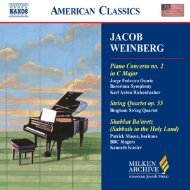Download Liner Notes PDF - Milken Archive of Jewish Music
Download Liner Notes PDF - Milken Archive of Jewish Music
Download Liner Notes PDF - Milken Archive of Jewish Music
You also want an ePaper? Increase the reach of your titles
YUMPU automatically turns print PDFs into web optimized ePapers that Google loves.
did have some correspondence with the University<br />
<strong>of</strong> Judaism concerning prospective graduate students<br />
and their projects, and in fact some serious work<br />
was accomplished. Cantor Philip Moddel’s valuable<br />
monograph on Joseph Achron, for example, began<br />
as his dissertation there. But the department never<br />
materialized on the level Helfman and Strassburg<br />
had envisioned.<br />
Helfman kept no central repository <strong>of</strong> his own works<br />
and no reliable catalogue; nor did he even date most<br />
<strong>of</strong> his manuscripts. After his premature, sudden death<br />
at sixty-two, many <strong>of</strong> his unpublished compositions<br />
and sketches had to be collected from a number<br />
<strong>of</strong> sources—a process that remains uncompleted.<br />
To this day Helfman manuscripts are occasionally<br />
discovered in archives, although some were published<br />
posthumously in the late 1960s. Some <strong>of</strong> his works<br />
may be lost permanently. At first glance, Helfman<br />
represents a cluster <strong>of</strong> contradictions:<br />
• Helfman the master liturgical composer whose<br />
pieces reveal the deepest nuances <strong>of</strong> prayers,<br />
yet who was not terribly religious in the<br />
traditional sense;<br />
• Helfman the conductor <strong>of</strong> one <strong>of</strong> the most<br />
left-wing, antinational Yiddishist choruses and<br />
the arranger <strong>of</strong> songs extolling the passions <strong>of</strong><br />
an international workers’ order, yet the<br />
champion <strong>of</strong> Zionist and <strong>Jewish</strong> nationalist and<br />
modern Hebrew culture;<br />
• Helfman the advocate <strong>of</strong> <strong>Jewish</strong> identity for<br />
youth, yet Helfman the universalist.<br />
Viewed in perspective, these were not contradictions,<br />
but the tensions that strengthened his art.<br />
Composer Jack Gottlieb remembers him as “a Pied<br />
Piper; a Svengali—a shaper <strong>of</strong> men.” Rabbi William<br />
Kramer summed up the Helfman phenomenon: “Max<br />
was a happening, and he caused other people to<br />
happen.” Helfman’s biographer and student, Philip<br />
Moddel, carried it one step further: “Max Helfman<br />
was an American happening.”<br />
—Neil W. Levin<br />
Program <strong>Notes</strong><br />
DI NAYE HAGODE<br />
Di naye hagode (The New Haggada, or The New<br />
Narrative) is a dramatic choral tone poem–cantata based<br />
on Itsik Fefer’s epic Yiddish poem about the Warsaw<br />
Ghetto Uprising—Di shotns fun varshever geto (The<br />
Shadows <strong>of</strong> the Warsaw Ghetto). The term haggada,<br />
which translates generically as “narrative,” is most<br />
commonly associated with the specific fixed narrative<br />
that is recited and reenacted at the Passover seder—the<br />
annual home ritual in which the ancient Israelites’<br />
exodus from Egypt, their liberation from bondage, and<br />
their embarkation on the path to a new, independent<br />
national as well as religious identity are recounted and<br />
celebrated. Helfman, who is presumed to have adapted<br />
Fefer’s words for his choral texts as well as for the English<br />
narration, took the title from the multiple appearances<br />
<strong>of</strong> this phrase within the poem. The hagode reference<br />
gave the piece a heightened historical and moral<br />
significance—not only because the uprising and the<br />
Germans’ final liquidation <strong>of</strong> the ghetto occurred during<br />
Passover, in 1943, but also because liberation, national<br />
survival, and, especially, the impetus for remembrance<br />
and undiluted recollection acquired a new and even<br />
more immediate meaning for the <strong>Jewish</strong> people in<br />
the post-Holocaust world. Just as all Jews are required<br />
annually to recall and relive the events <strong>of</strong> the exodus<br />
from Egypt, and just as they are obligated to transmit<br />
the story to their children in each generation, so did<br />
Fefer exhort his people to tell this story—if for no other<br />
reason than perpetually to pay homage to the brutally<br />
murdered Jews <strong>of</strong> the Warsaw Ghetto who died with<br />
the collective honor <strong>of</strong> resistance: “Forever blessed are<br />
they who remember the graves…. And whoever does<br />
not maintain the wrath [against the Jews’ murderers]<br />
shall be forever cursed.”<br />
There were nearly 400,000 known <strong>Jewish</strong> residents<br />
<strong>of</strong> Warsaw—about a third <strong>of</strong> the city’s overall<br />
population—when the German army entered the<br />
8.559440<br />
Helfman_<strong>Liner</strong>Nts 9440.indd 9<br />
12/5/05 1:03:51 PM
















